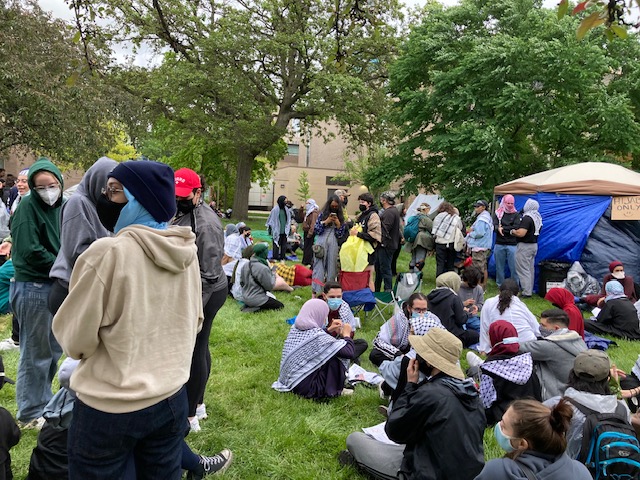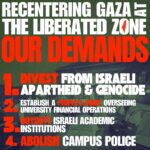Dianne Feeley
Posted July 14, 2024

Students for Justice in Palestine (SJP), stymied by the refusal of the Wayne State University Board of Governors to discuss divesting its investments in military corporations doing business in Israel, initiated an encampment. On May 23rd, as the university moved into its summer session, these students set up their camp opposite the undergraduate library.
An additional demand called for cutting the tie between the campus and Israeli police. In 2019, WSU Police Chief Anthony Holt traveled to Israel for a seven-day, 10-hours-a-day training in law enforcement strategies. He wrote a glowing report of how the training represented an “international model.”
The decision to set up the encampment followed from the April 26th Board of Governors meeting, where students felt they had been shut down and hustled out. With an estimated 186,000 Palestinians killed and tens of thousands more injured, the entire population of Gaza has been displaced. For many students, these were family members. Still other students had family in the West Bank, where Israeli settlers were driving Palestinians from their land.
As a public university, WSU does not have the endowment and investments of an elite campus such as Colombia University. In fact, only two percent of the total university revenues come from its investments. According to the university, its investment aims are to manage risks and safeguard assets. The only investment policy prohibition is against a direct investment in the tobacco industry. Since 2022, Commonfund handles the WSU investments along with many other public and private colleges and universities. Its values include a commitment to trust, transparency and ethical behavior.
Given this background, it is certainly possible for the Board of Governors to engage in discussions with students and divest its holdings in war-profiting companies. Instead, the university has failed to listen to SJP or the many other campus organizations that early on called for the university to support a permanent ceasefire. The first day I went to the encampment, the majority I met were young women who wore hijabs. While I was there, two administration representatives came to speak. One stated that the use of the lawn was “illegal” and requested that the encampment disband. He explained that the administration was so concerned about the students’ health and safety that they set up next to the encampment two toilets and a dumpster for garbage. He also complained that some items, such as safety cones, had been moved to the camp. He invited students to attend a meeting in a few weeks’ time, where they could learn about the university’s investment aims. Meanwhile, the second person took photos of us. Given the circumstances of the U.S.-Israeli war in Gaza, I thought the performance could have been a perfect “Saturday Night Live” skit — except, of course, the stakes are much higher.
These administration talks took place daily as the encampment grew over the Memorial Day weekend. On Monday, a rumor that the encampment would be raided went out, and by that evening about 200 students, faculty, staff and community members stood by. Students from the University of Michigan encampment that had been raided the week before came, with several prepared to spend the night. U.S. Representative Rashid Tlaib and State Representative Abraham Alyash slept overnight as well. By 5:30 Tuesday morning, those of us who had left the night before were back; once again there were about 200 people present in case the raid had been rescheduled.
Instead of ordering a raid, the administration chose to shut the campus down. An early-morning message transferred all classes online, with all staff and faculty who could work from home to do so. But isolating the encampment from daily university life revealed just how peaceful the encampment was. Some staff set up their workstations at the camp, the encampment organized events, including print-making, and faculty members came by.
Administration representatives arrived on Wednesday with an offer that the steering committee meet with President Esby. The committee considered the proposal and agreed if the president would meet at the camp at 6PM. But she never arrived. Instead, at 5:30 on Thursday, May 30, campus and Detroit police announced that people had 10 minutes to leave the encampment or face arrest. With a second warning, the police moved in and arrested 12. Although police did not use pepper spray as they had at the University of Michigan, they did grab and violently detain students. One young student’s hijab was pulled off as she was arrested. Five seem to have been targeted as the “leaders” and booked, while seven others were given trespassing tickets and released.
Before 9AM, students regrouped and marched along Detroit city sidewalks to a main campus entry point. Police stood, guarding the paths and then put up yellow tape as we could see campus vehicles destroying the encampment. That day, the rally eventually moved to the detention center and cheered the five who emerged with their lawyers and family late afternoon. By 7PM, over 125 people, mostly students, attended a People’s Trial.
Less than a week later, a rally back at the WSU campus entrance, “Hands Off Our Students,” was sponsored by the newly formed Faculty and Staff for Justice in Palestine. Speakers read from the faculty’s open letter and explained that their organization had exactly the same demands as SJP. The rally ended with a march up the paths to where the encampment had been — and the only place on campus where the water sprinklers were turned on.
On June 11, there was another “Hands Off Our Students” event, a coalition effort organized by faculty members and students, including the Black Student Union and the Wayne State Peace Coalition. Most speakers were young Arab and Black women and other people of color. They spoke of how they no longer feel isolated and are learning how they have strength together. One spoke of how her grandparents were driven from their home in Palestine in 1967. Another was born in Palestine but was forced to move to the United States with her family as a small child. As people read Palestinian poems, paintings from Gaza flashed on the screen.
The event focused on the long and sometimes complicated relationship between the Black and Arab communities in the Metro Detroit area, stressing the importance of unity. Speakers described how the fight against slavery and colonialism was the same fight, and pointed to how Martin Luther King spoke out against colonialism. They emphasized how the polluted water in Flint and in Gaza represented the same fight. They drew a parallel between the death of George Floyd and the killing of Palestinians in Gaza. They spoke of the history of organizing in Detroit between Arab autoworkers and the Dodge Revolutionary Union Movement (DRUM) in the 1970s. They are committed to the struggle for divestment — and determined to see it grow.



Leave a Reply